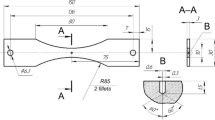An ultimate hardening model of materials has been developed, which is based on allowance for hardening in the fatigue fracture zone. Using this model, the high-cycle life of materials is estimated. The hardening function and the relation of its parameters to fatigue life have been described. An original method for the determination of model parameters on the basis of fatigue curve by its characteristic points is proposed.
Similar content being viewed by others
References
V. T. Troshchenko, P. P. Lepikhin, L. A. Khamaza, and Yu. N. Babich, “Computerized Data Bank “Strength of Materials”,” Strength Mater., 41, No. 3, 235–242 (2009).
V. T. Troshchenko, L. A. Khamaza, and G. V. Thybanev, Methods for the Rapid Determination of Endurance Limits of Metals on the Basis of Strain and Energy Criteria [in Russian], Naukova Dumka, Kiev (1979).
N. N. Afanas’ev, Statistical Theory of the Fatigue Strength of Metals [in Russian], Ukrainian SSR Academy of Sciences Publishers, Kiev (1953).
E. Orowan, “Theory of the fatigue of metals,” Proc. Roy. Soc. A, 171 (944), 79–106 (1939).
V. S. Ivanova and V. F. Terent’ev, Nature of the Fatigue of Metals [in Russian], Metallurgiya, Moscow (1997).
M. Klesnil and P. Lucas, Fatigue of Metallic Materials, Academia, Prague (1980).
S. Sasaki and Y. Ochi, “Some experimental study of fatigue slip bands and persistent slip bands during fatigue process of low-carbon steel,” Fract. Mech., 12, 531–540 (1979).
G. V. Tsybanev and M. V. Tsybanev, “Model of ultimate hardening of material as a criterion of crack initiation under high-cycle loading,” in: Dynamics, Strength, and Service Life of Machines and Structures [in Ukrainian], Abstracts of Papers presented at International Scientific-Technical Conference, Institute of Problems of Strength of the National Academy of Sciences of Ukraine, Kiev (2005), Vol. 2, pp. 361–362.
V. A. Nikolaevich, Maple 10. Textbook for Self-Instruction [in Russian], Dialektika, Moscow (2006).
E. G. Makarov, Engineering Design in Mathcad. Handbook [in Russian], Dialektika, Moscow (2005).
M. Ya. Vygodskii, Handbook of Higher Mathematics [in Russian], Nauka, Moscow (1975).
Yu. I. Koval’, “The kinetics of the change in inelastic cyclic deformations in 45 and 1Kh13 steels under steady and programmed loading,” Strength Mater., 6, No. 3, 277–281 (1974).
G. V. Tsybanev and A. I. Novikov, “Determination of the parameters of cyclic hardening diagram from the results of high-cycle fatigue tests of material,” in: Reliability and Life of Machines and Structures [in Ukrainian] (2008), Issue 30, pp. 160–168.
V. S. Ivanova, T. S. Mar’yanovskaya, and V. F. Terent’ev, “Rapid method for the construction of French line using energy fatigue criteria,” Zavod. Lab., No. 2, 225–228 (1966).
Author information
Authors and Affiliations
Additional information
Translated from Problemy Prochnosti, No. 6, pp. 122 – 136, November – December, 2010.
Rights and permissions
About this article
Cite this article
Tsybanev, G.V., Novikov, A.I. Computational model of the ultimate hardening of materials under high-cycle fatigue and determination of its parameters. Part 1. Description of the model. Strength Mater 42, 717–727 (2010). https://doi.org/10.1007/s11223-010-9259-4
Received:
Published:
Issue Date:
DOI: https://doi.org/10.1007/s11223-010-9259-4




